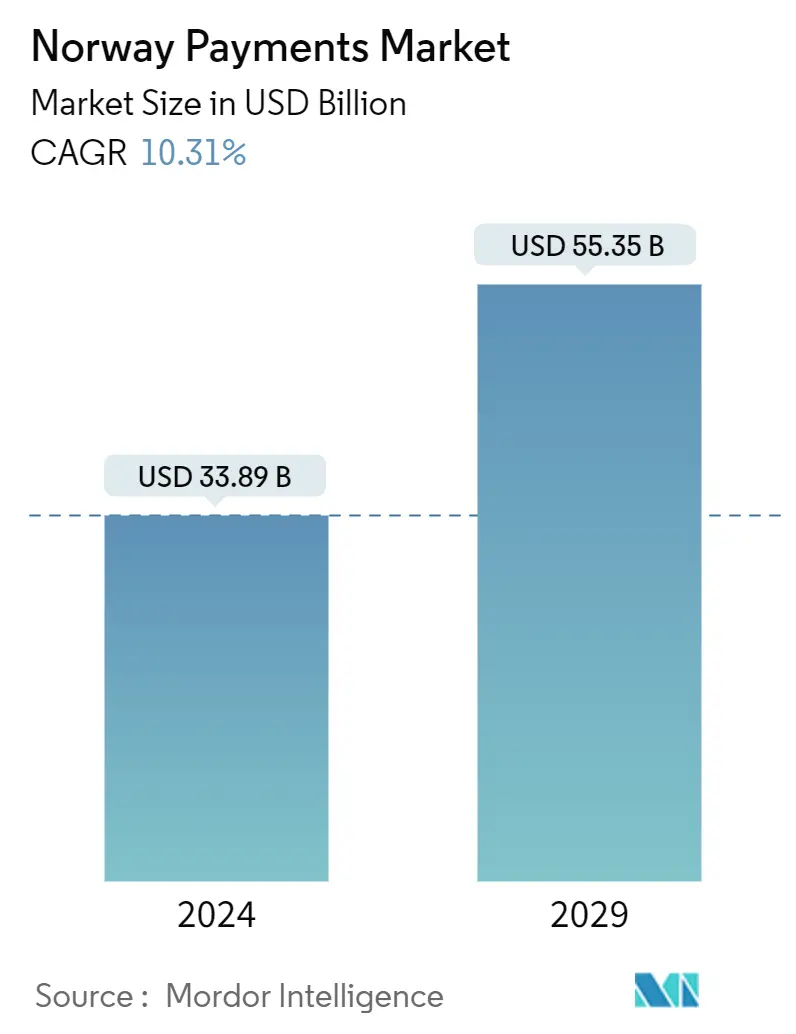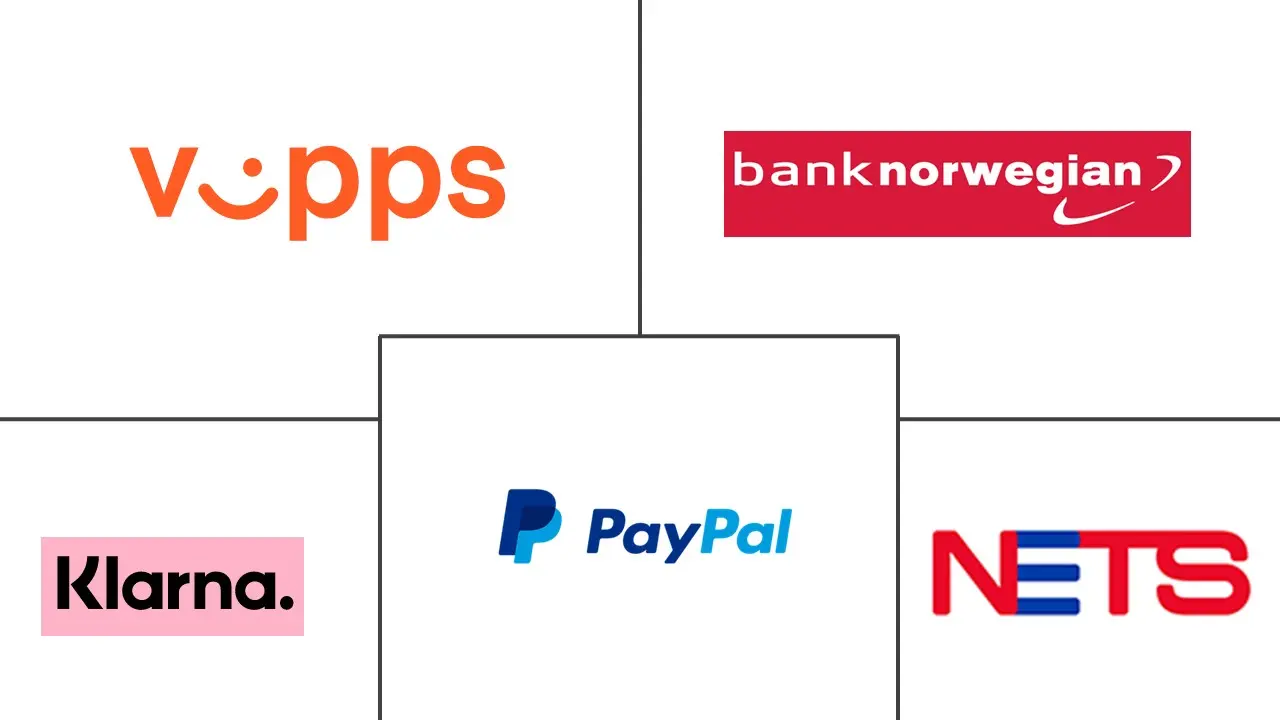Market Size of Norway Payments Industry

| Study Period | 2019-2029 |
| Base Year For Estimation | 2023 |
| Market Size (2024) | USD 33.89 Billion |
| Market Size (2029) | USD 55.35 Billion |
| CAGR (2024 - 2029) | 10.31 % |
| Market Concentration | Low |
Major Players
*Disclaimer: Major Players sorted in no particular order |
Norway Payments Market Analysis
The Norway Payments Market size is estimated at USD 33.89 billion in 2024, and is expected to reach USD 55.35 billion by 2029, growing at a CAGR of 10.31% during the forecast period (2024-2029).
E-commerce payment preferences are shifting away from cash and credit cards to digital wallets and buy now, pay later options (BNPL). Credit cards' dropping share is due to the rise of alternative payment methods, volume transferring to credit- and debit-linked digital wallets, customers choosing interest-free credit in BNPL, and credit-centric sectors like travel recovering from pandemic damage.
- The Norway payment system is gradually shifting from cash to digital payments. Payments are becoming increasingly cashless, assisting in the growth of digital economies and payment infrastructure innovation. Contactless payments are becoming more popular in a variety of places throughout the world. Contactless payment solutions at the point of sale, such as face recognition, Quick Response (QR) codes, or Near-field Communication (NFCs), are transforming the countries' payment environment.
- Apps for mobile banking are becoming more popular. App developers can identify the immediate impact of these apps and create them to satisfy the needs of all users. Because of artificial intelligence, banking consumers receive assistance. Instead of being forced to visit a physical location, customers now have more options than earlier.
- The mobile transaction market has evolved, and more and more service providers are requesting new mobile payment solutions - as surcharged text message payments and as accurate mobile payments. Despite the widespread use of credit cards, substantial cash is still circulating. On the other hand, mobile and contactless technology will provide consumers with payment options as convenient as cash.
- However, while digital payment systems offer advantages, there also pose privacy and security risks that can impact customers, merchants, markets, and governments and impede the market growth. Payment systems must be modified to ensure privacy while employing strong encryption and open standards. Data privacy legislation and a strong market regulator are also necessary.
- The pandemic-induced lockdown and mobility restrictions significantly impacted e-commerce in Norway, driving demand to new highs, bringing new shoppers and sellers into digital platforms, and offering players long-term growth. The containment efforts introduced people to online buying and motivated experienced online buyers to make more purchases, making the e-commerce business one of the largest beneficiaries of the pandemic. This helped e-commerce payments or online sales become a key metric in the market studied.
Norway Payments Industry Segmentation
The payments market is segmented by two modes of payment, POS and e-commerce. E-commerce payments include online purchases of goods and services, such as purchases on e-commerce websites and online bookings for travel and accommodation. However, they do not include online purchases of motor vehicles, real estate, utility bills (such as water, heating, and electricity), mortgage payments, loans, credit card bills, or purchases of shares and bonds. In the POS segment, all transactions at the physical point of sale are included in the market scope. It includes traditional in-store transactions and all face-to-face transactions, regardless of where they occur. Cash is considered for both cases (cash on delivery for e-commerce sales).
The Norway payments market is segmented by mode of payment (point of sale (card payments, digital wallet, cash), online sale (card payments and digital wallet)). The market sizes and forecasts are provided in terms of value in USD for all the above segments.
| By Mode of Payment | ||||||
| ||||||
|
Norway Payments Market Size Summary
The Norway payments market is experiencing a significant transformation, driven by a shift from traditional cash and credit card transactions to digital payment solutions. This evolution is largely fueled by the increasing popularity of digital wallets and buy now, pay later (BNPL) options, which are reshaping consumer payment preferences. The rise of contactless payment methods, such as QR codes and Near-field Communication (NFC), is further enhancing the convenience and efficiency of transactions. Mobile banking apps are gaining traction, offering users seamless and secure payment experiences without the need for physical bank visits. Despite the ongoing use of cash, the trend towards cashless transactions is bolstering the growth of digital economies and payment infrastructure in Norway.
The market landscape is characterized by the presence of major players like Vipps AS, Nets A/S, Bank Norwegian, and Klarna Bank AB, who are actively engaging in partnerships, mergers, and innovations to strengthen their market position. The pandemic has accelerated the adoption of e-commerce, with digital payment systems becoming integral to online shopping experiences. Regulatory initiatives and advancements in digital literacy are further supporting the expansion of digital payments. However, challenges such as privacy and security concerns remain, necessitating robust encryption and regulatory frameworks. The ongoing development of mobile payment solutions and digital wallets is expected to continue driving market growth, offering consumers convenient alternatives to traditional payment methods.
Norway Payments Market Size - Table of Contents
-
1. MARKET INSIGHTS
-
1.1 Market Overview
-
1.2 Industry Stakeholder Analysis
-
1.3 Industry Attractiveness-Porter's Five Forces Analysis
-
1.3.1 Bargaining Power of Suppliers
-
1.3.2 Bargaining Power of Buyers/ Consumers
-
1.3.3 Threat of New Entrants
-
1.3.4 Threat of Substitute Products
-
1.3.5 Intensity of Competitive Rivalry
-
-
1.4 Evolution of the payments landscape in the country
-
1.5 Key market trends pertaining to the growth of cashless transaction in Norway
-
1.6 Assessment of Impact of COVID-19 on the Market
-
-
2. MARKET SEGMENTATION
-
2.1 By Mode of Payment
-
2.1.1 Point of Sale
-
2.1.1.1 Card Payments (includes Debit Cards, Credit Cards, Bank Financing Prepaid Cards)
-
2.1.1.2 Digital Wallet (includes Mobile Wallets)
-
2.1.1.3 Cash
-
2.1.1.4 Other POS Payment Modes
-
-
2.1.2 Online Sale
-
2.1.2.1 Card Payments (includes Debit Cards, Credit Cards, Bank Financing Prepaid Cards)
-
2.1.2.2 Digital Wallet (includes Mobile Wallets)
-
2.1.2.3 Others (includes Cash on Delivery, Bank Transfer, and Buy Now, Pay Later)
-
-
-
Norway Payments Market Size FAQs
How big is the Norway Payments Market?
The Norway Payments Market size is expected to reach USD 33.89 billion in 2024 and grow at a CAGR of 10.31% to reach USD 55.35 billion by 2029.
What is the current Norway Payments Market size?
In 2024, the Norway Payments Market size is expected to reach USD 33.89 billion.

